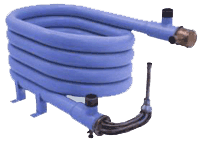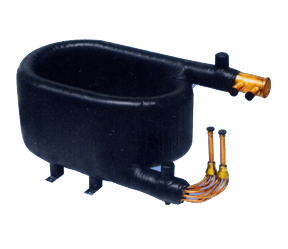| The
heat exchanging tubes are tube bundles with riffled tube and outer tubes are seamless
steel tubes covered with thermal insulation materials. The refrigerant evaporates
through forced convection in the heat exchanging tubes and cools the tube walls.
The circulating water flows outside the tube bundles and heats the tube walls
through forced convection. The two medium exchanges heat via walls of the heat
exchanging tubes. In established utilization scope, flows on both sides of the
tube walls are vigorous turbulent flows.
The
heat exchanging tube bundles are symmetrically distributed into a helical structure
of specific thread intervals. Such a structure enables the tube pass length, serviceable
conditions, reliability, and heat-exchanging boundary situations of all tubes
are the same. In addition, under the co-function of helical tubes and the inner
threads, secondary circulation flows in vertical direction to the main flow are
formed in the tubes. Complicated irregular channels with helical features are
formed in the intervals between the helical tube bundles and outer tube cases.
As a result, powerful secondary circulating flows are formed from the circulation
water. The secondary circulation flows on both sides prominently strengthen the
heat exchanging effects. Liquid
distributors are installed in the refrigerant inlet to ensure that the flow supply
to each tube pass is even and uniform, so as to make full use of the heat exchanging
surface. |
|  The series of screw coaxial heat exchangers have
the following features: The series of screw coaxial heat exchangers have
the following features:
1. Rational structure and outstanding performance
The SCE series of screw coaxial heat exchangers have been designed on the basis
of summarizing the existing domestic and overseas designing experiences and after
lots of simulation calculations and dissection experiments. The designs are comprehensively
optimized, the structure is more rational, and the performances are even better.
2. Using choice materials and with reliable
functions
Quality copper tubes with riffled threads and low ribs up to
GB/T8890-1998 are chosen as heat exchanging tubes. As for the outer casing tubes,
quality seamless liquid tubes with smooth inner walls, up to GB/T8163-1987 are
chosen and processed with hot galvanizing techniques. Compared with weld steel
tubes, seamless tubes do not involve the risk of welding seam breaking from the
vibrations and pressure impacts during long period of operations and the risks
of the copper tubes' being punctured by burrs on the inner walls of the seams.
Therefore, its long-term service is highly reliable. 3. Pressure and vibration resistance and low
deforming risks
In the practical operations of refrigeration systems,
influenced by temperature fluctuations, circulation starting and stopping, the
heating pumps' defrosting, and expansion valve adjustments, the internal pressure
is always under frequent alterations. Under high or frequently changing pressure,
plate heat exchangers are liable to deform, fatigue, and be damaged. But coaxial
round pipe structure is much more capable in terms of high pressure and impact
resistance. Therefore, screw coaxial heat exchangers can better suit the complicated
practical operation situations of refrigeration systems. 4. Dirt and clog resistant
As screw
coaxial heat exchangers' side water flow passages are of large sections and facilitate
the passing of large fibers and sands in the water, the passages are unlikely
to be clogged. For the same reason, scale deposits forming on the tube walls from
hard water are unlikely to cause clogs. Therefore, screw coaxial heat exchangers
have strong water quality permission range. 5. Unhindered lubricant circulation and high
security
There is no upright ascending passage in the refrigerant flowing
process of screw coaxial heat exchangers and even if the flow is small, the lubricant
can surely return to the compressor. It is unnecessary to worry about such risks
as reduction in heat exchanging area, passage clogging, instability in operation,
and damages to the compressor because of lubricant blocking in the evaporators.
6. Top techniques and little leakage risk
During
the manufacturing process of screw coaxial heat exchangers, it is only necessary
to connect a few places at the entrances and exits of tubes and the connecting
techniques are far simpler and easier than those on other heat exchangers. It
is easy to guarantee the connecting quality and control the risks of leakage at
connecting points from long term of vibrations, fluctuating pressure, and temperature
alterations. 7. Flexible structure and convenient to collocate
screw coaxial heat exchangers have unique advantages in terms of structure
flexibility because the outer tubes can almost be processed into any shape according
to the users' needs and so are the locations and directions of outlet and inlet
tubes. Although the tubes may occupy a large area, as they are hollow inside,
other parts of the system can be placed here. Besides, at more and more occasions,
the users request the heights of heat exchangers be lowered as much as possible
and screw coaxial heat exchangers can perfectly meet the users' designing requests. 8. Low price and cost effectiveness
As
it is unnecessary to use a lot of such expensive metal as stainless steel and
aluminum and complicated manufacturing techniques, the users are able to purchase
heat exchangers of the same capacity at lower prices and the manufacturing costs
of whole units can be effectively decreased. Additionally, as screw coaxial heat
exchangers wear well, they can help the whole unit manufacturers save large amount
of after-sales service expenses. 9. The products can be of multiple circuits
According
to the clients' requests, this product can be built into heat exchangers of single
water circuit, two freon circuits, or multiple freon circuits to satisfy the requirements
of multiple system mainframes, perform energy adjustment, and meet the society's
current needs for energy saving. |